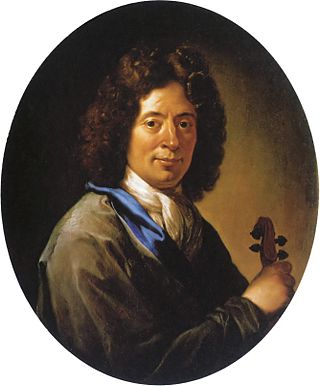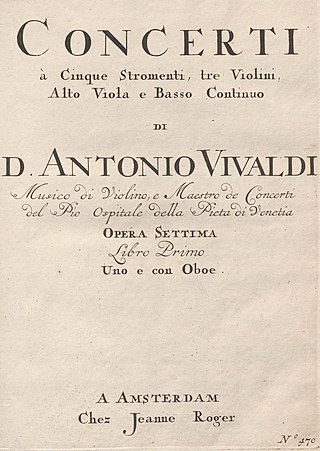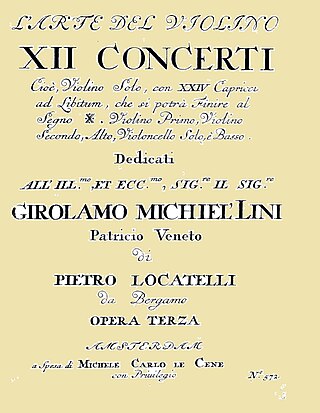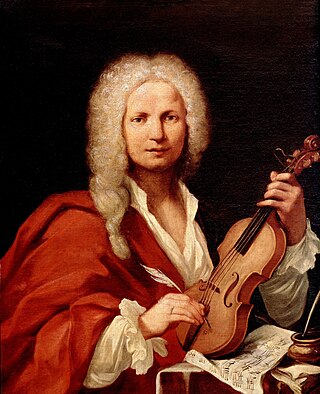A concerto is, from the late Baroque era, mostly understood as an instrumental composition, written for one or more soloists accompanied by an orchestra or other ensemble. The typical three-movement structure, a slow movement preceded and followed by fast movements, became a standard from the early 18th century.

Arcangelo Corelli was an Italian composer and violinist of the Baroque era. His music was key in the development of the modern genres of sonata and concerto, in establishing the preeminence of the violin, and as the first coalescing of modern tonality and functional harmony.
The concerto grosso is a form of baroque music in which the musical material is passed between a small group of soloists and full orchestra. This is in contrast to the solo concerto which features a single solo instrument with the melody line, accompanied by the orchestra.

The Brandenburg Concertos by Johann Sebastian Bach are a collection of six instrumental works presented by Bach to Christian Ludwig, Margrave of Brandenburg-Schwedt, in 1721. The original French title is Six Concerts Avec plusieurs instruments, meaning "Six Concertos for several instruments". Some of the pieces feature several solo instruments in combination. They are widely regarded as some of the greatest orchestral compositions of the Baroque era.

Trevor David Pinnock is a British harpsichordist and conductor.

L'estro armonico, Op. 3, is a set of 12 concertos for string instruments by Italian composer Antonio Vivaldi, first published in Amsterdam in 1711. Vivaldi's Twelve Trio Sonatas, Op. 1, and Twelve Violin Sonatas, Op. 2, only contained sonatas, thus L'estro armonico was his first collection of concertos appearing in print. It was also the first time he chose a foreign publisher, Estienne Roger, instead of an Italian. Each concerto was printed in eight parts: four violins, two violas, cello and continuo. The continuo part was printed as a figured bass for violone and harpsichord.

Twelve concerti grossi, Op. 6, is a collection of twelve concerti written by Arcangelo Corelli probably in the 1680s but not prepared for publication until 1714. They are among the finest and first examples of concerti grossi: concertos for a concertino group and a ripieno group of strings with continuo. Their publication – decades after their composition and after Italian composers had moved to favor the ritornello concerto form associated with Vivaldi – caused waves of concerto grosso writing in Germany and England, where in 1739 George Frideric Handel honored Corelli directly with his own "Opus 6" collection of twelve.
Giuseppe Valentini, nicknamed Straccioncino, was an Italian violinist, painter, poet, and composer, though he is known chiefly as a composer of inventive instrumental music.

Concerto grosso in G minor, Op. 6, No. 8 by Arcangelo Corelli, known commonly as the Christmas Concerto, was commissioned by Cardinal Pietro Ottoboni and published posthumously in 1714 as part of Corelli's Twelve concerti grossi, Op. 6. The concerto bears the inscription Fatto per la notte di Natale. Its composition date is uncertain, but there is a record of Corelli having performed a Christmas concerto in 1690 for the enjoyment of his new patron.
Pieter Hellendaal was a Dutch composer, organist and violinist.

A set of twelve concertos was published by Estienne Roger in 1716-1717 under Antonio Vivaldi's name, as his Opus 7. They were in two volumes, each containing concertos numbered 1-6. Of the set, ten were for violin solo; the other two were for oboe solo. The authenticity of some of the works included has long been doubted by scholars. Three are now considered spurious for stylistic reasons. They are: No. 1 in B-flat major for oboe, RV Anh. 143 ; No. 7 in B-flat major for oboe, RV Anh. 142 ; and No. 9 in B-flat major for violin, RV Anh. 153.

La stravaganza [literally 'Extravagance'], Op. 4, is a set of concertos written by Antonio Vivaldi in 1712–1713. The set was first published in 1716 in Amsterdam and was dedicated to Venetian nobleman Vettor Delfino, who had been a violin student of Vivaldi's. All of the concertos are scored for solo violin, strings, and basso continuo; however, some movements require extra soloists.
A triple concerto is a concerto with three soloists. Such concertos have been composed from the Baroque period, including works by Corelli, Vivaldi, Bach and Telemann, to the 21st century, such as two works by Dmitri Smirnov. The most famous example is Beethoven's Triple Concerto for violin, cello and piano. His combination of solo instruments, a piano trio, was often used also in later works.
An organ concerto is an orchestral piece of music in which a pipe organ soloist is accompanied by an an orchestra, although some works exist with the name "concerto" which are for organ alone.

The Twelve Grand Concertos, Op. 6, HWV 319–330, by George Frideric Handel are concerti grossi for a concertino trio of two violins and cello and a ripieno four-part string orchestra with harpsichord continuo. First published by subscription in London by John Walsh in 1739, they became in a second edition two years later Handel's Opus 6. Taking the older concerto da chiesa and concerto da camera of Arcangelo Corelli as models, rather than the later three-movement Venetian concerto of Antonio Vivaldi favoured by Johann Sebastian Bach, they were written to be played during performances of Handel's oratorios and odes. Despite the conventional model, Handel incorporated in the movements the full range of his compositional styles, including trio sonatas, operatic arias, French overtures, Italian sinfonias, airs, fugues, themes and variations and a variety of dances. The concertos were largely composed of new material: they are amongst the finest examples in the genre of baroque concerto grosso.
The Musette, or rather chaconne, in this Concerto, was always in favour with the composer himself, as well as the public; for I well remember that HANDEL frequently introduced it between the parts of his Oratorios, both before and after publication. Indeed no instrumental composition that I have ever heard during the long favour of this, seemed to me more grateful and pleasing, particularly, in subject.

L'arte del violino is a noteworthy and influential musical composition by Italian Baroque violinist and composer Pietro Locatelli. The twelve concerti were written for solo violin, strings, and basso continuo and were published in 1733 as the composer's third opus. The virtuosic style and artistry present in the work strongly influenced violin playing in the 18th century and cemented Locatelli's reputation as a pioneer of modern violin technique.

The Concerti grossi, Op. 3, HWV 312–317, are six concerti grossi by George Frideric Handel compiled into a set and published by John Walsh in 1734. Musicologists now agree that Handel had no initial knowledge of the publishing. Instead, Walsh, seeking to take advantage of the commercial success of Corelli's Concerti grossi, Op. 6, simply combined several of Handel's already existing works and grouped them into six "concertos".

Grosso mogul, also Il grosso mogul, or capitalised [Il] Grosso Mogul, RV 208, is a violin concerto in D major by Antonio Vivaldi. The concerto, in three movements, is an early work by the Venetian composer. Around the mid-1710s Johann Sebastian Bach transcribed the concerto for organ, BWV 594, in C major. A simplified version of the violin concerto, RV 208a, without the elaborated cadenzas that appear in manuscript versions of RV 208, and with a different middle movement, was published around 1720 in Amsterdam as concerto #11 of Vivaldi's Op. 7.
The Sinfonie di concerto grosso is the title of twelve works for flute, strings and basso continuo by Alessandro Scarlatti, composed in Naples from June 1, 1715 - the same year as the performance of his opera Tigrane, one of his greatest successes, and his oratorio La Santissima Trinità.













